|
|
|
Sort Order |
|
|
|
Items / Page
|
|
|
|
|
|
|
| Srl | Item |
| 1 |
ID:
146505
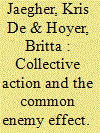

|
|
|
|
|
| Summary/Abstract |
How is collective defence by players affected when they face a threat from an intelligent attacker rather than a natural threat? This paper analyses this question using a game-theoretic model. Facing an intelligent attacker has an effect if players move first and visibly set their defence strategies, thereby exposing any players who do not defend, and if the attacker is, moreover, not able to commit to a random attack. Depending on the parameters of the game, the presence of an intelligent attacker either increases the probability that players jointly defend (where such joint defence either does or does not constitute a utilitarian optimum), or decreases the probability that players jointly defend (even though joint defence is a utilitarian optimum).
|
|
|
|
|
|
|
|
|
|
|
|
|
|
|
|
| 2 |
ID:
146501
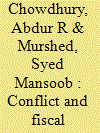

|
|
|
|
|
| Summary/Abstract |
We examine the role of war in retarding state fiscal capacity in developing countries, measured by tax revenue ratios to GDP. We build a simple theoretical model of a factionalized state, where patronage substitutes for common interest public goods, along with violent contestation over a rent or prize. Our dynamic panel empirical analysis applied to 79 developing countries, during 1980–2010, indicates that war, especially civil war, retards fiscal capacity, along with imperfect democracy, political repression, poor governance, and dependence on oil and macroeconomic mismanagement. High intensity conflict is particularly destructive of state capacity. In countries experiencing low intensity wars, other institutional factors may matter more than war. The diminution of fiscal capacity due to war appears less pronounced after the end of the cold war.
|
|
|
|
|
|
|
|
|
|
|
|
|
|
|
|
| 3 |
ID:
146508
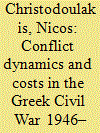

|
|
|
|
|
| Summary/Abstract |
Using a new set of data from Greek Army sources, US military archives, and Communist Party documents, the paper provides a quantitative analysis of the armed confrontation that took place in Greece during 1946–1949. A dynamic Lotka–Volterra model is estimated, pointing to the existence of a conflict trap that explains the prolongation of the civil war and its dire consequences for the country. A regional analysis finds that the mobilization of guerrilla forces was crucially affected by morphology and the local persecutions of political rivals. Using neoclassical growth-accounting, the economic cost of the conflict is estimated to surpass an annual GDP, in line with similar findings in contemporary civil wars. The same framework is employed to assess the outcome in counterfactual situations discussed in this paper.
|
|
|
|
|
|
|
|
|
|
|
|
|
|
|
|
| 4 |
ID:
146502
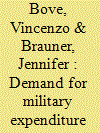

|
|
|
|
|
| Summary/Abstract |
This paper examines whether there are systematic differences in military spending between different types of autocratic regimes. We view military expenditure as an instrument a dictator can exploit in order to stay in power. How he utilises this instrument depends on the institutional set-up of his regime. We distinguish between military regimes, single party states and personalist regimes, and predict that military regimes should have the highest, whereas personalist dictatorships should have the lowest level of military spending. Using panel data on 64 dictatorships from 1960 to 2000, we find empirical evidence that our hypotheses are not rejected.
|
|
|
|
|
|
|
|
|
|
|
|
|
|
|
|
| 5 |
ID:
146509


|
|
|
|
|
| Summary/Abstract |
This paper investigates the effect of military spending on external debt in case of Pakistan for the period of 1973–2009. For this purpose, the autoregressive distributed lag bounds testing approach to cointegration is used to examine cointegration among the variables. The ADF, P-P, and ADF-GLS unit root tests are applied to test the integrating order of the variables. The Ordinary Least Square (OLS) and error correction method regressions are used to investigate the marginal impact of military spending on external debt in the long and short run. Our findings indicate the existence of cointegration that confirms the presence of a long-run relationship among military spending, external debt, economic growth, and investment. Further, our results reveal that a rise in military spending increases the stock of external debt; an increase in investment also increases external debt; however, there is an inverse effect of economic growth on external debt. An implication of the findings reported herein is that there is a need to formulate a comprehensive economic policy for curtailing external debt in case of Pakistan.
|
|
|
|
|
|
|
|
|
|
|
|
|
|
|
|
| 6 |
ID:
146507


|
|
|
|
|
| Summary/Abstract |
This paper examines the interaction between a growth-oriented terrorist organization and an uninformed government based on a two-period signalling game. Combining the signalling game and organizational growth approaches of previous contributions, this paper shows that, if a terrorist group follows a growth strategy, it has an incentive to appear weaker than it is by mimicking the behaviour of a smaller organization. Depending on its beliefs about the extent of the terrorist threat, it can be optimal for a government to spend more on second-period counter-terrorism measures if it is not attacked in the first period than if it were attacked.
|
|
|
|
|
|
|
|
|
|
|
|
|
|
|
|
| 7 |
ID:
146504
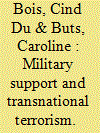

|
|
|
|
|
| Summary/Abstract |
Analysing the relationship between the provision of military support and the probability of becoming the target of a terrorist attack, this paper contributes to the literature on the causes of transnational terrorism. We find that deployment of military troops of country X in country Y increases the probability of a terrorist attack on citizens of country X by a terrorist group located in country Y. Exporting weapons to country Y seems to increase the probability of being attacked by the terrorists of this country Y as well. Deploying materials, however, does not seem to significantly influence the probability of attack. Including lagged values for our military support variables ensures that the causality direction is from military support to terrorist attacks. Moreover, these results indicate that while the effect of military deployment on the probability of attack lasts for more than 1 year, the effect is rather short-lived.
|
|
|
|
|
|
|
|
|
|
|
|
|
|
|
|
|
|
|
|
|